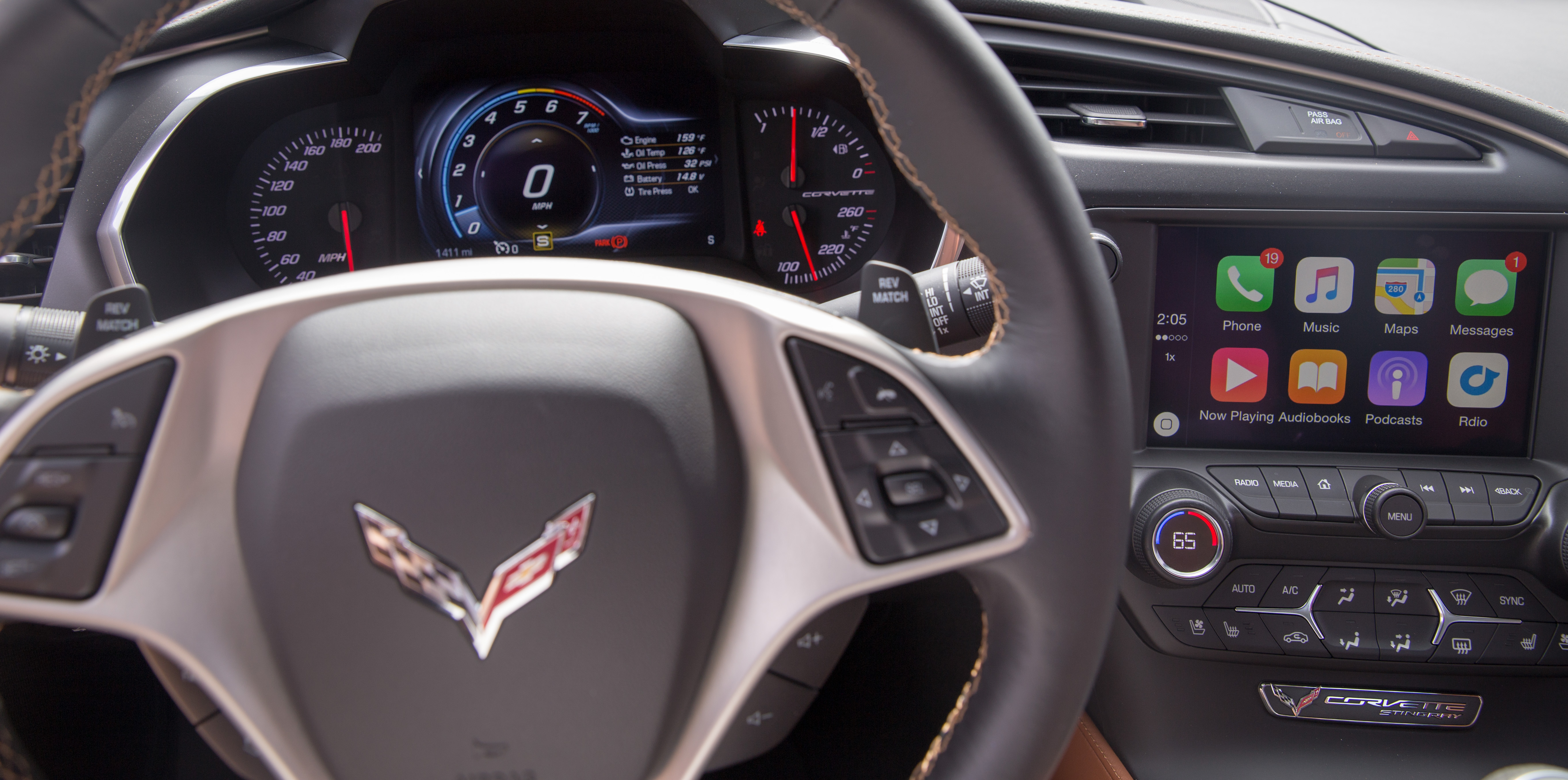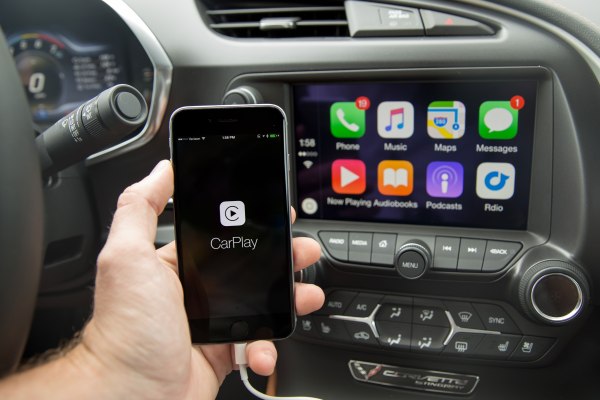The streamlined 2016 Corvette Stingray is one of the first vehicles to ship with Apple CarPlay in the States. Simply put, it’s an iPhone for your dashboard, which Apple and car makers hope you’ll use instead of the iPhone in your hand.
First, the bad news: CarPlay is far from perfect. It’s boring, for one. And in many cases I found the Corvette’s own infotainment system handled tasks better than CarPlay.
Yet it’s hard to ignore what CarPlay is. It’s the culmination of Apple’s mobile services. Everything from Siri to Maps to Apple Music feels more at home in a car than a phone. Even in this early version, CarPlay trumps any human interaction platform offered by any automaker and it’s all thanks to Siri.
Apple announced CarPlay over two years ago and it’s finally making its way into vehicles. The system looks much the same as it did when announced. The aim is the same too: When an iPhone is connected, Apple’s in-vehicle software takes over the car’s main screen. Drivers are presented with large, hard to miss icons of possible tasks from placing a phone call to responding to messages to listening to music — all items safer done through CarPlay than directly on a phone.
CarPlay is an additional interface to the standard system already in the car. The car also has all the standard AM/FM and connected services. CarPlay sits in the background until an iPhone is plugged in.
Don’t Smartphone And Drive
Safety through ease of use is the goal with CarPlay. Vehicle manufacturers have long struggled to provide elegant software solutions that are not distracting or easy to use. Called infotainment systems, this software often runs on a large screen mounted in the center of the dash. Every car maker has a different interface and they’re often radically different. Apple is attempting to standardize this screen — and for that matter, so is Google with Android Auto.
A recent J.D. Power report found that many drivers simply not using some of the technology packed into their new cars often because they use their smartphone instead. “In many cases, owners simply prefer to use their smartphone or tablet because it meets their needs; they’re familiar with the device and it’s accurate,” said Kristin Kolodge, executive director of driver interaction & HMI research at J.D. Power, in the study.
With CarPlay and Android Auto, the software is designed specifically to work in conjunction with a connected phone. Apple and Google know that drivers have a hard time ignoring their phones so CarPlay and Android Auto bring common tasks to the dashboard.
Tasks and connectivity are off-loaded to the connected phone. With CarPlay and Android Auto, cars do not need to have their own dedicated data connection — something that’s become a pricey add-on. The phone itself serves up the goods and the car’s screen simply relays the information in a format better suited for in-car use.
The goal is to have a driver not use their phone while driving. In this regard, CarPlay succeeds, but it could be a bit more elegant.

CarPlay sits on top of a vehicle’s native infotainment system, hidden, waiting for iPhone. Wireless connections are not supported. CarPlay currently only works when an iPhone is connected using a Lightning cable. Bluetooth is not supported.
Once an iPhone is plugged in, CarPlay pops up. Or it doesn’t. I found the interaction to be inconsistent although I couldn’t pin down the fault on Apple or the Chevy infotainment system.
Either way, when enabled and an iPhone is connected, a CarPlay logo is featured on the ‘Vette’s main screen alongside Audio, Phone and other icons. If you happen to leave the CarPlay environment, this is how you get back. And sometimes you need to leave CarPlay as it does not completely replace the car’s infotainment system.
Tasks like using the FM radio are still done with the car’s built-in system. Essentially, if the connected iPhone does not have the ability or function, CarPlay does not either.
Siri Rides Shotgun
Apple employs Siri for nearly every interaction. Just like on an iPhone, Siri can change the music, send a text, launch an app or provide navigation. Yet in the car, using Siri is a lot more natural than with a phone.
How often do you use Siri on your phone to transcribe or read text messages? It’s key to using CarPlay. Tell Siri to play a song and seconds later it blasts from the car’s speakers thanks to Apple Music. Command Siri to take you to the nearest McDonald’s, and she’ll pop directions on the screen without complaining about the health risks.
Siri is accessed either through a button on the steering wheel or the home button in CarPlay. Once summoned, Siri acts in a similar fashion as in iOS.
Siri is CarPlay’s main attraction. Car makers have attempted to bring the power of voice to vehicles, but without a data connection, like Siri or Google Now uses, these voice systems have never provided comprehensive natural language support, often requiring users to navigation voice menus with specific prompts and steps. A driver can talk to Siri in a natural way and more often than not, Siri will respond in kind.
Messages are composed through Siri’s voice dictation. It’s clear that Apple took pain in making this process as quick as possible, but it still takes a few seconds for Siri to run through her script, which involves re-reading your text message and asking if you would like to send it. At no point is text displayed on the screen.
Likewise, when a message is received, Siri will read the content. Again, the goal with CarPlay and Google’s Android Auto is to keep drivers from picking up their phone. Sadly, CarPlay has very limited notification support. Right now it’s limited to Apple’s apps like iMessage, Calendar and Maps. Do not expect Siri to read your Twitter DMs while you’re driving.
CarPlay is the natural environment for Apple Maps and Siri provides an easy way to input destinations. Tell Siri to take you to a McDonald’s and the route is instantly loaded on the car’s screen.
Car makers have struggled with destination input yet Apple, thanks to the evolved natural language capability of Siri, nailed it on the first try. But Apple Maps still leaves something to be desired.
Apple has improved Maps dramatically since its launch in 2012. But it’s still not Google Maps. Apple Maps lacks traffic information that has long been found in Google Maps and others like Waze. Apple Maps also lacks a lot of contextual information that would be handy in a vehicle. To be clear, Apple Maps will not get you lost, but it could also get you stuck in traffic.
[gallery ids="1201050,1201048,1201040,1201042,1201041,1201044,1201046,1201045,1201043"]
Apple’s Ecosystem
To get the most out of CarPlay, you need to use Apple’s apps. Say someone emails you about a meeting and you stick the event in Apple Calendar. CarPlay will not only notify you about the calendar event, but provide directions if the original email includes an address — just like on an iPhone. This sort of interaction is not possible with 3rd party apps.
CarPlay will only display notifications from Apple’s apps and there isn’t a way to throw other services into the mix. So, for instance, if you left iMessage for Telegram or Facebook Messenger, CarPlay will not display the notifications. Or, say, you use Google Calendar, CarPlay will not pass along the notification that you’re late to a meeting.
Forget about using CarPlay to put Waze on your dashboard. CarPlay’s only mapping solution is Apple Maps.
Apple keeps CarPlay’s environment locked-down, yet hands the keys to several handpicked companies. CarPlay works with major audio streaming services such as Pandora, Spotify, Pandora and Audible. It also works with CBS Radio and MLB At Bat, which has a clever audio streaming service.
This sort of limitation hampers the overall appeal of CarPlay. While the service does succeed in bring the iPhone to the dash, it doesn’t bring my iPhone to the dash since I do not use most of Apple’s apps.
An iPhone For Your Dash
CarPlay is by far the easiest to use in-vehicle software available. It’s initiative and simple. If Apple’s aim was to make CarPlay accessible to everyone, the company succeeded.
Part of this ease of use comes from the limited functions. CarPlay does not have to handle as many tasks and functions as a built-in infotainment system. It doesn’t have to deal with terrestrial radio or car settings.
CarPlay is essentially a second screen for an iPhone. Tasks are often mirrored. Select Messages on the car’s display and the connected iPhone will also load the messages screen on its screen. The same goes for Maps and Music and third party apps like Pandora. The CarPlay interface is feed from the iPhone. The iPhone does all the rendering and processing.
The first thing noticeable is that CarPlay is kind of dated. Coming from the swanky (and perhaps busy) Chevy MyLink infotainment system, CarPlay looks stark and plain. And not in a healthy way.
The icons and user interface elements seem out of place inside of a brand new car. At the same time, they’re familiar in a boring sort of way. It’s an iPhone screen in your dash. Cool. I guess.
Designing in-car human elements is an art and I’m not sold on ascetics of CarPlay. That’s not to say that it’s better than Chevy’s MyLink system, which is often overcrowded with information and colors and text and things.
With CarPlay there seems to be a lot of wasted space. Android Auto seems to be a more happy medium between the bareness of CarPlay and the overloaded stock infotainment system from Chevy, Chrysler and many others.
CarPlay feels like a beta product and it’s reasonable to expect it to improve over time. Since the connected iPhone itself runs CarPlay, when the iPhone is updated, so is CarPlay.
Right now, CarPlay is just kind of boring, which I’ll concede is perhaps the goal. Often boring equals safe. Apple removed a lot of the distracting elements from the screen. The icons are large and text is easy to read — and there isn’t a lot of text, either.
iPhone users will feel instantly at home with CarPlay. The learning curve is essentially flat. Plug an iPhone into the car and CarPlay instantly works like an iPhone.
[gallery ids="1201999,1202000,1202001,1202002,1202003,1202004,1202005,1202006,1202007,1202008"]
As for the 2016 Corvette Stingray itself, the 6.2L V8 engine was plentiful and the seven speed manual transmission brought a smile to my face. After getting my fill of CarPlay, I turned off the radio and enjoyed the sweet sounds performed by an American V8 symphony.
This is the latest version of the C7 Corvette platform. GM introduced the redesigned ‘Vette in 2013. This example costs $70,000 thanks to the Z51 2LT trim package that features larger wheels, slotted brakes and a performance package. It even packs a data recorder that includes a GoPro-style camera that will record and log adventures.
The engine is smooth and hungry for speed yet the car is content cruising at mundane speeds. This comes from the fantastic seven speed gear box that’s designed for speed, but also efficiency. Chevy says the Corvette can get 29 MPG on the highway.
The ‘Vette is stunning. Sleek lines, sharp edges and electric blue. CarPlay is just OK.
CarPlay should be a pleasant surprise for iPhone owners. Car makers and Apple have been fairly mum about its availability. Apple says 34 auto manufacturers are committed to making the system available in their cars. The Corvette is just the start for GM. Most General Motors’ cars will be available with CarPlay by the end of the year. VW is also rolling the system out en mass.
Thanks to Siri, CarPlay lets drivers use their phones while driving while actually not using their phones. It’s good, but it needs to get better.
